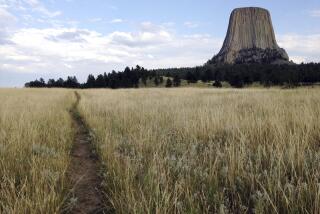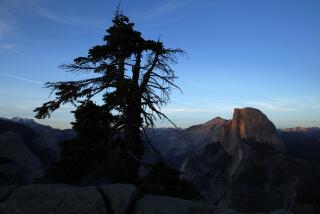Avalanche Survivor Describes His Ordeal : Injured Climber Will Go Again--More Carefully
- Share via
Craig Peer expects to be back scaling mountains within 18 months, adding yet another climb to his 500 or so previous ones and doing what he always does when he reaches the top--planning his next assault.
“Once you reach the top it’s completely anticlimactic,” the 28-year-old from Rancho Palos Verdes said last week. “The real thrill of climbing is to work through your fears. You learn to develop a lot of self-control.”
Peer’s self-control was put to the ultimate test last month. He had journeyed to the southernmost tip of South America and had climbed a peak in the Andes when he:
- Was awakened in the middle of the night while perched high on a mountain ledge. He heard a “whooshing” noise. It was an avalanche.
- Discovered that the “crunch” he heard was his leg, which had been hit by a boulder about the size of a bowling ball and crushed.
- Was forced to wait two days in an ice cave on top of a glacier until a helicopter plucked him from the mountain.
- Found himself a celebrity of sorts in the Chilean press, his name and picture plastered across the pages of several tabloids.
Desire to Live
“I think I’ve toned down some of my plans,” Peer said when asked if the experience had changed him. “I would like to live to become a very old climber.”
Peer, a graduate of Palos Verdes High School who works in construction to support his climbing, returned home 11 days ago after spending Christmas about 8,000 miles away in a Chilean hospital.
Now living with a friend in the Burbank hills, Peer said his doctor predicts it will be several months before he will be able to shed his hip-high cast.
In the meantime, he is working on an article about his experience and recounting his tale to visitors in a low-key style with some humor thrown in--a humor his father, Ken Peer, is well acquainted with.
“When he called from the hospital in Chile, he said, ‘Dad, I have some good news and I have some bad news,’ ” his father recalled. “He said, ‘The good news is that we’re down and alive. The bad news is that I broke my leg.’ He also said the good news was that the hospital only costs $28 a day.”
The younger Peer said he first became interested in mountain climbing as a Boy Scout while backpacking in the Sierra Nevada. Eventually, he said, he began scaling peaks in Yosemite National Park and became good enough to teach others how to climb.
Peer said that while most of his climbs have been in Yosemite--he has scaled 7,564-foot El Capitan five times--he has also scaled two mountains in Mexico, including Orizaba, the 18,700-foot peak that is the third highest in North America.
Peer said he had always wanted to travel to the Patagonian region of South America. So when Dave Davies, a South African climber he had met through friends, invited him to go to the Andes to climb, he accepted. The two were joined by Jonathan Gordon, another South African and a friend of Davies.
The trio left Los Angeles on Oct. 23, first flying to Argentina and then on to Puerto Natales, a small town in Chile near Torres del Paine, a national park. The park includes three side-by-side peaks, the torres (towers) from which it takes its name. According to Peer, they were first climbed in 1963 and have been climbed only 10 times since.
“Their appeal lies in the fact that they are so difficult to climb because of the weather conditions,” Peer explained. “The worst thing is the winds that sound like a turbofan on a Boeing 747. There was one gust of wind that knocked us all over.”
Days of Preparation
The three men, who had decided to scale the 2,500-foot southernmost tower, established a base camp on a glacier near the bottom of the peak. For days they prepared for their assault, attaching a rope to the sides of the rocky tower. On Dec. 20 they climbed to within 500 feet of the top and camped on a small ledge. They planned to complete their climb the following day.
“I was completely sound asleep, and then I heard a whoosh and a crunch. I had been hit by a rock,” Peer said. “I threw myself over the ledge (a rope was tied around his body). I was screaming ‘My leg is broken!’ ”
Peer said he managed to pull himself back onto the ledge, and his companions calmed him down.
Gordon had been injured slightly in the avalanche when he was hit on the head by a small rock, but Davies had emerged unscathed. Davies made his way back down the peak to the base camp to retrieve an inflatable splint from the snow cave the men had built.
Leaky Splint
Davies returned about six hours later and the two put the splint on Peer’s leg and lowered him back down to the cave. The splint had an air leak, and Peer’s companions had to keep blowing more air into it.
“By this time, I’m in a panic,” Peer recalled. “Any little rock would (fall by) and I’m screaming.”
On Dec. 22, the three decided that Davies and Gordon would go for help. Because the weather was warm and the ice cave was beginning to deteriorate, the three decided that one climber could not make the trip safely. Peer was left in his sleeping bag in the cave.
“I would look over my shoulder and (hear) rocks flying,” Peer said. At one point, he scribbled the words “waiting to die” on his small calendar.
But on Dec. 23, Peer said, he heard a machine, which turned out to be a police helicopter that had managed to swoop down close to the cave when some clouds lifted.
Time Short
“Dave ran in, blew up my splint, and said ‘We’ve got two minutes to get out of here. There’s no time to worry about pain,’ ” Peer said.
Peer said he was dragged outside and onto a stretcher, loaded onto the helicopter and taken to a hospital in Puerto Natales. Because of the severity of his leg injury, he was immediately transferred to a larger hospital in the city of Punta Arenas.
Because his doctor spoke English, Peer said he was aware just how badly his leg had been broken. He said he waited until the day after Christmas to call his parents so he would not spoil their holiday.
Peer said he spent about a week in the hospital. Friends brought him clothes and other items.
Despite his misfortune, Peer said he hopes to return to South America. And, he said, he would like to organize a climb of El Capitan for some of his Chilean friends who helped him through his ordeal.
But, he added, no matter what peak he may climb, he has no desire to take any unnecessary risks. “Maybe I’m getting a little older and wiser,” he said.
More to Read
Sign up for Essential California
The most important California stories and recommendations in your inbox every morning.
You may occasionally receive promotional content from the Los Angeles Times.










